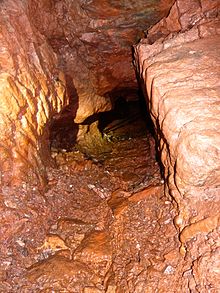Role (mining)
With roll , or roll hole called is referred to in the mining a vertical or oblique shaft-like compound from an upper track in an underlying. The term is derived from the rolling of the conveyed material .
task

The roller hole is used to connect different levels underground for the downward conveyance of debris or material, for example ore from the mining in a conveying device ( hunt or conveyor belt ) in the base section . Another function is the intermediate storage.
Executions
Rolls are used in various mining industries. The designs vary according to the geology and the selected mining method.
Ore and potash mining
The oldest roll forms come from Ganger ore mining and were used here specifically for building ridge and ridge joints. The role was provided with wood construction or drywall and left out in the offset. It was always in the collapse of the corridor. Due to the way they were made, they had a rectangular cross-section. In modern non-gangue ore mining and potash mining, roles were often driven separately in the adjacent rock. This was done either by drilling and shooting or by drilling large holes. These roles were mostly saiger and had different cross-sections (rectangular, elliptical or round).
Hard coal mining
In hard coal mining , rollers were used in steep seams for inclined storage construction. The execution here is similar to that used in Ganger ore mining, i.e. H. the role was left out in the offset. The bunkers with spiral chutes or stacking shafts used in modern hard coal mining are technically also roller holes.
Lignite mining
In early lignite mining , especially in the Rhenish Revier , small pits around 1900 were often used in roller-hole operation , which was a hybrid of surface and underground mining. A tunnel was driven underground into the lower area of the coal face (seam). Over the course of the day, the seam was exposed from overburden and then a funnel-shaped pit was dug down to the tunnel. Once the connection was established, the tusker let the chunks of coal (nibbles) loosened by hand slide through the roller hole down into the tunnel, where a wagon or lorry was waiting on rails to pick up the coal and transport it away. The roll hole in this case was a slot that moved with the dismantling; the mining followed the course of the tunnel. Since only a limited width could be covered in this way, several parallel tunnels were used.
Promotion in roller holes
In the dismantling stage, the supply is carried out by gravity, manual labor, with fixed ( scraper , conveyor system ) or mobile means of transport ( bunker loader , loader , conveyor wagon ). The upper opening of the roller hole is usually covered by a grating, which has the task of withstanding too large conveyed goods in order to prevent blockages. Furthermore, the grating is used for occupational safety, as it prevents the risk of falling. The goods to be conveyed fall into the roller until the roller lock. For reels with saigeren heights over 10 m you should therefore never pull the reel completely empty in order not to damage the closure. The roller lock is used for the dosed delivery of the rolled goods to the respective conveyor.
Terms
The lock at the bottom of the roll hole is called the “roll snout”. Before the mechanization of the mining industry, roller snouts were usually made of wood and operated by a simple lever. Steel later replaced wood as the material and the roller lock was actuated by pneumatic or hydraulic pressure cylinders.
Individual evidence
- ↑ Fritz Heise, Fr. Herbst, Carl Hellmut Fritzsche: Textbook of mining science, with special consideration of hard coal mining. 8th edition. Volume 1, Springer-Verlag, Berlin 1942, p. 428
- ^ Peter Zenker: Brown coal mining in Neurath . Self-published, 2003, p. 31–32 ( full text on tzenker.org [PDF]). Full text on tzenker.org ( Memento of the original from June 17, 2007 in the Internet Archive ) Info: The archive link was inserted automatically and has not yet been checked. Please check the original and archive link according to the instructions and then remove this notice.
literature
- Walter Bischoff , Heinz Bramann, Westfälische Berggewerkschaftskasse Bochum: The small mining dictionary. 7th edition, Verlag Glückauf GmbH, Essen, 1988, ISBN 3-7739-0501-7
- Ernst-Ulrich Reuther: Introduction to mining. 1st edition, Verlag Glückauf GmbH, Essen, 1982, ISBN 3-7739-0390-1
- G. Leithold et al .: Taschenbuch Bergbau . Civil engineering. Ed .: Chamber of Technology, Association of Mining. tape III . German publishing house for basic industry, Leipzig 1962, p. 489 .





